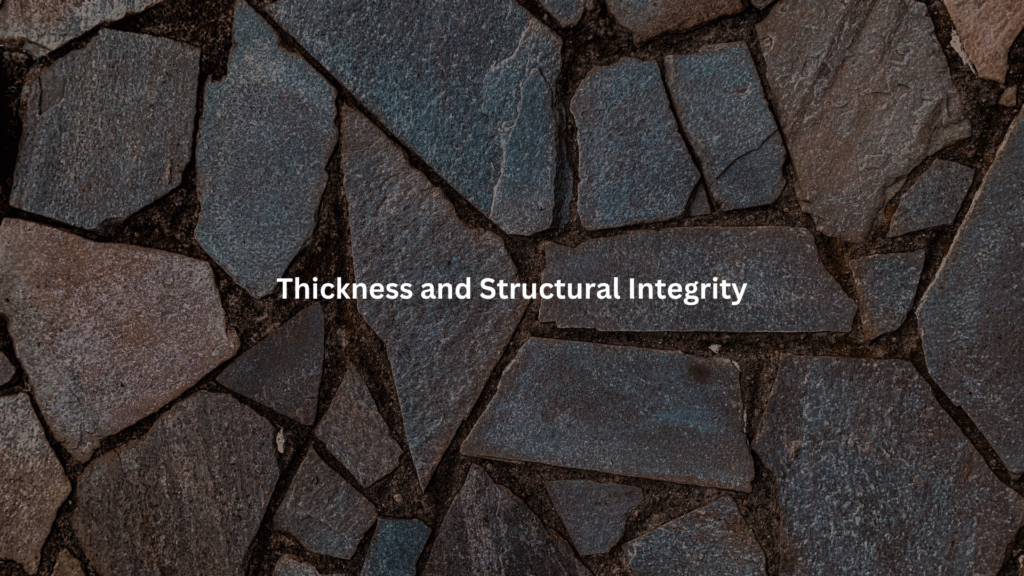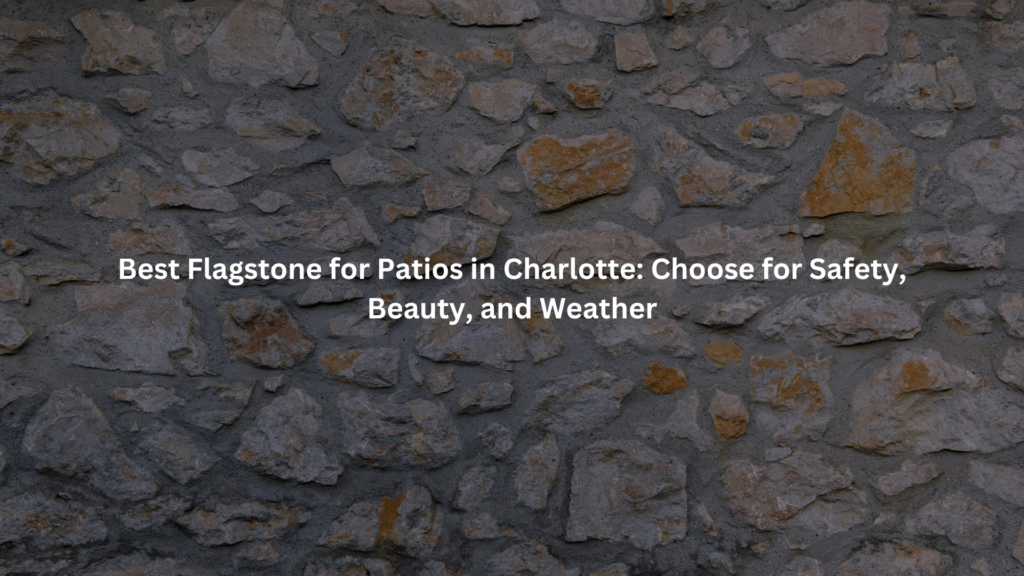Find out which flagstones last longest in Charlotte, resist slips, and bring out the natural beauty of your patio.
Use flagstone that won’t crack after the first cold snap and keeps its footing in summer storms. Choose textures that don’t get slick after rain, and colors that suit the Carolina Piedmont’s red clay and green canopy. Pick stones thick enough to handle years of grilling, foot traffic, and the occasional basketball bounce. Some flagstones do all this better than others.
Key Takeaway
- Dense stones like bluestone and quartzite last longest and resist Charlotte’s wet-dry swings.
- Texture and thickness matter more than color for safety and durability.
- Choose flagstone based on both local weather and your own design style.
Selecting Flagstone Based on Environmental Factors
First, think about where Charlotte sits. This city never gets the deep freeze of the Midwest, but it does get those January nights where puddles freeze and thaw. Summers? Warm. Humid. Afternoon storms, sometimes sudden. The ideal flagstone won’t flinch at a little water or a week of heavy heat.
Climate Considerations
Flagstone patios in Charlotte need to stand up to two main things: quick temperature swings and long spells of humidity. If you use a stone that’s too porous, it soaks up water then cracks when the temperature drops. That’s happened to my neighbor’s sandstone walk. You want a stone that shrugs off both water and heat.
Freeze-Thaw Resistance
Dense stones like bluestone and quartzite barely notice freeze-thaw cycles. Lay them dry with a good gravel base, and water drains away before it ever gets trapped. Sandstone and Arizona flagstone can work, but you risk more flaking or pitting if winter gets rowdy. Most suppliers in Charlotte recommend at least 1.5 inches thick, but We’ve seen thinner stones pop right off their beds after a cold snap.
Mild vs. Humid Climate Suitability
Charlotte isn’t Phoenix. Humidity lingers for months. Limestone holds up well, its tight grain resists moss and mildew. Slate is another option for humid yards, especially if you want a natural cleft surface with grip. Sandstone’s more for drier, milder climates, unless you’re ready to seal it yearly.
Slip Resistance and Safety
The safety of your patio comes down to texture and installation. Smooth stones might look elegant, but after a summer storm, they’re as slippery as a creek rock. Flagstones with a natural cleft or split surface, like bluestone or slate, grip shoes even when wet. For pool decks or spots where kids run barefoot, skip the polished look and stick to coarse, uneven textures.
Maintenance Requirements
Every flagstone needs some care. Some less than others. Here’s what you really sign up for:
Sealing and Weather Protection
- Bluestone and Quartzite: Benefit from sealing every couple of years, especially where leaves stain or pollen settles thick.
- Sandstone and Arizona Flagstone: Seal these yearly if used in Charlotte. They stain and weather faster.
- Limestone: Watch for acid (fertilizer runoff, some cleaners). Otherwise, seal for easier sweeping and to slow down mildew.
Dry laid flagstone, set in stone dust or fine sand, lets water move through naturally, which helps prevent winter damage. Mortared joints look neater but can crack and need patching. [1]
Thickness and Structural Integrity

My uncle built his first patio with inch-thick flagstone. By the third autumn, half the stones wobbled. For patios or high-traffic spaces, you want at least 1.5 inches thick. For driveways or spots with heavy furniture, go for 2 inches or more.
Recommended Thickness for Durability
- Patios and Walkways: 1.5 to 2 inches thick
- Stepping Stones: 1.5 inches minimum, thicker if set in grass or mulch
- Pool Decks/High Traffic: 2 inches or more
If you go thinner, expect to replace pieces over time. Thicker stones cost more up front, but save on repairs.
Specialty Flagstones and Unique Features
Some flagstones just look different. Others have quirks that make them better, or harder to live with, in Charlotte.
Arizona Flagstone
Arizona flagstone’s got those warm, earthy tones, reds, pinks, and golds. It fits right in with southern clay and wood decks. Easy to cut, easy to shape. But it’s more porous. After a few years of Carolina rain and the odd freeze, you’ll see some weathering. It’s best for spots that drain well and aren’t in constant shade.
Color and Pattern Appeal
- Wide range: tan, rust, pink, buff
- Natural art: swirling bands, fossil traces
- Good for: statement patios, flower beds, or as stepping stones
Regional Suitability and Weathering Factors
Arizona flagstone works better where winters are mild. In Charlotte, expect some flaking unless you’re diligent with sealing and quick to sweep off leaves.
Quartzite
Quartzite is tough. It’s a metamorphic stone, once sandstone, now hardened by pressure. That means it’s highly resistant to wear, rain, and even pool chemicals. Looks glassy, almost metallic, with colors like silver, gold, blue, and tan.
Durability and Chemical Resistance
- Won’t stain easily
- Survives heavy traffic and chemical splashes (even saltwater)
- Stays slip resistant even when wet
Maintenance and Installation Challenges
Quartzite is hard to cut. You’ll spend more on labor or tools if you want intricate shapes. Still, for spots where you want a patio to last a long time, think outdoor kitchens or pool decks, it’s worth the effort.
Design and Practical Considerations for Patios
Flagstone patios aren’t just about what lasts. They’re about what looks right, feels right, and fits your life. [2]
Aesthetic Choices
Matching flagstone to your landscape means thinking about both color and shape. Bluestone’s gray-blue looks modern, almost formal. Arizona flagstone feels casual, rustic, warm. We’ve seen patios where the stones echo the colors of local red clay or Carolina pines. For a traditional Charlotte look, mix tan and gray stones, and keep the shapes irregular.
Matching Flagstone Colors to Landscape and Architecture
- Red brick homes: try gray or blue flagstone for contrast
- White or light siding: tan, gold, or buff stones blend well
- Wood decks: earthy Arizona flagstone or brown sandstone
Think about how the stone will look wet. Some stones (quartzite, bluestone) darken and get richer, while sandstone and limestone barely change.
Installation Tips
Credits: Handyman Startup
Installation’s where the art comes in. Dry laid flagstone patios, stones set on a bed of gravel and stone dust, drain quickly and flex with the ground. Mortared patios look crisp but need more prep and maintenance.
Cutting, Shaping, and Laying Flagstone
- Use larger stones for main areas, smaller for edges or flower beds.
- Keep joints tight (no more than 1 inch if possible). Wide joints invite weeds.
- Alternate shapes and sizes for a natural look.
- Tap each piece into a bed of stone dust or sand. Check for wobble before moving on.
- For a paver patio look, use cut flagstone with straight edges.
Patios set in fine sand or stone dust let water run through, which keeps freeze-thaw damage to a minimum in Charlotte’s unpredictable climate.
Cost and Budget Factors
Flagstone patios aren’t cheap. They’re worth it if you want a surface that ages gracefully, but expect a higher initial cost compared to concrete pavers or poured concrete.
Price Range Comparisons Among Flagstones
- Bluestone: 6–6–6–12 per square foot (material only)
- Sandstone: 4–4–4–8 per square foot
- Limestone: 5–5–5–10 per square foot
- Slate: 7–7–7–15 per square foot
- Arizona Flagstone: 4–4–4–8 per square foot
- Quartzite: 8–8–8–20 per square foot
Dry laid patios cost less to install than mortared ones. Labor’s the biggest variable, more cutting and shaping means higher price.
Longevity and Performance
Patios built with denser stones and thicker pieces last decades. My grandfather’s bluestone patio in Winston-Salem still looks good after forty years, just a few replaced pieces. Sandstone and Arizona flagstone might need more regular upkeep, especially in shaded or damp corners.
Practical Advice: Choosing for Charlotte’s Climate and Your Backyard
Pick flagstone like you’d pick shoes for a Carolina spring, something that won’t slip, won’t crack, and still looks good with a little red clay on it. Denser stones like bluestone and quartzite handle Charlotte’s wet springs and mild winters with ease. Arizona flagstone brings color, but needs extra care against humidity and freeze-thaw.
If you want a flagstone patio that lasts a long time:
- Stick with stones at least 1.5 inches thick.
- Choose a naturally textured, slip resistant surface, especially if you’re near a pool or expect barefoot traffic.
- Seal every couple of years, sweep often, and keep an eye out for moss or shifting stones.
FAQ
How does the shape and texture of flagstone affect its slip resistance and patio safety?
Irregular flagstone with a textured surface can be more slip resistant than smooth, cut flagstone, especially in wet conditions. For high traffic areas like a backyard patio, this matters a lot. Some types of flagstone are naturally slip resistant, while others may get slippery when wet. A good step guide considers the weather conditions in your area and helps pick a flagstone that balances safety and aesthetic appeal.
Why does natural flagstone work better in extreme weather compared to other patio materials?
Natural flagstone is highly durable and less likely to crack in freezing temperatures or warp in heat. In areas with extreme weather, dry stone methods allow the flagstone to shift slightly without damage. That flexibility, along with its natural appearance and minimal maintenance needs, makes it an excellent choice for patios and walkways exposed to rain, sun, and snow over the long term.
Can different types of flagstone impact patio cost and long-term upkeep?
Yes, the type of stone used directly affects patio installation costs and future maintenance. Limestone flagstone, for example, may have a lower upfront price but can wear down faster in harsh climates. A wide range of flagstone options offer different pros and cons. Choosing low maintenance flagstone with a resistant surface can reduce costs over the long term, especially in outdoor living spaces with high use.
How does flagstone work with flower beds, stepping stones, or other landscape materials?
Flagstone is a popular choice for tying together outdoor spaces like patios, flower beds, and stone walkways. Irregular flagstone fits well in naturalistic landscape design. Smaller pieces of flagstone make excellent stepping stones between beds. The color variations and natural look of flagstone allow it to blend into existing landscape materials without clashing, turning a patio into part of a complete outdoor living space.
What design ideas work best for integrating flagstone into a backyard patio?
Flagstone pavers can follow curved paths or be arranged in tighter patterns for a cleaner look. Beacon Hill flagstone or traditional flagstone styles both work well depending on your desired aesthetic. Use an outdoor idea center or design idea catalog to browse our extensive shapes and sizes. Combine flagstone with a paver patio or natural stone borders to transform your space into a cohesive, textured outdoor living area.
Conclusion
In the end, the best flagstone for patios in Charlotte is the one that fits your style, your budget, and how much upkeep you’re okay with. Think about your yard’s odd angles, your home’s look, and how you’ll actually use that space. A little planning now saves headaches later. The right flagstone can turn plain grass into a welcoming outdoor room.
Contact Lapis Patios to find the best flagstone for patios that truly fits your space.
References
- https://www.doityourself.com/stry/how-to-weather-proof-your-flagstone-patio
- https://www.hgtv.com/outdoors/outdoor-remodel/flagstone-patios

